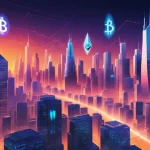Layer-1 Blockchains Drive $18.9T RWA Tokenization Surge by 2033

RWAs Boom as Layer-1 Blockchains Ignite $18.9T Tokenization Surge
The market for tokenized real-world assets (RWAs) is on track to explode to $18.9 trillion by 2033, driven by the powerhouses of Layer-1 blockchains like Ethereum, Stellar, Avalanche, and Injective. These platforms are not just reshaping finance; they’re tearing down the old and building the new, brick by digital brick.
- Tokenized RWAs projected to hit $18.9T by 2033
- Ethereum leads with 60% of RWA tokenization value
- Stellar aims for $3B in on-chain RWA value this year
- Avalanche and Injective focus on expanding RWA utility in DeFi
- Challenges include liquidity, demand, and regulatory hurdles
Ethereum’s Current Dominance
Ethereum is currently the heavyweight champion of RWA tokenization, accounting for 60% of the market. As the first major blockchain to support smart contracts, Ethereum has paved the way for the tokenization of everything from art to real estate. But with great power comes great responsibility—and Ethereum’s high gas fees and scalability issues are no secret. The blockchain world is buzzing with solutions like Ethereum 2.0, but until then, Ethereum must juggle its crown with care.
Stellar’s Rapid Growth
Stellar isn’t just catching up; it’s sprinting ahead in the RWA race. With over $470 million in tokenized assets, Stellar is the second-largest Layer-1 blockchain for RWA value. Denelle Dixon, the executive director of the Stellar Development Foundation, boasts, “
Stellar is the second largest Layer-1 for RWA value after Ethereum, with around $470 million in tokenized treasuries, commodities, and yield-bearing stablecoins on the network.
” What’s more, tokenizing securities on Stellar can transform a $50,000 transaction fee into a mere $120, slashing costs from $1 to less than a penny. Stellar’s goal? To power $3 billion in RWA value on-chain this year. And with major players like Franklin Templeton’s OnChain U.S. Government Money Market Fund, which holds $466.5 million on the Stellar network, and Societe Generale-Forge’s EUR-backed stablecoin, Stellar is making big moves.
Avalanche’s Focus on DeFi
Avalanche is all about speed and efficiency, and it’s laser-focused on digitizing and tokenizing global assets. Morgan Krupetsky, senior director of business development at Ava Labs, declares, “
Avalanche was purpose-built for this next generation of blockchain-enabled finance.
” With its ability to handle many transactions quickly, sub-second finality, and low transaction costs, Avalanche is a prime candidate for RWA tokenization. WisdomTree’s expansion onto Avalanche with tokenized funds and Intain’s platform, which has administered over $6 billion in tokenized loans, show that Avalanche is not just talking the talk—it’s walking the walk.
Injective’s DeFi Integration
Injective isn’t just about tokenizing RWAs; it’s about making them work within DeFi. Eric Chen, co-founder of Injective, states, “
The goal for us isn’t just about RWA issuance, but rather activating real utility in DeFi, from secondary trading to margin and lending use cases.
” With a market for tokenized assets already exceeding $10 billion, Injective is creating compliant RWA tokenization with utilities that bring these assets into the DeFi fold. They’re not just tokens; they’re tools for the decentralized future.
Challenges and Hurdles
The RWA boom isn’t without its challenges. Creating consistent demand, ensuring liquidity, and navigating regulatory frameworks are like trying to solve a Rubik’s cube in the dark. Morgan Krupetsky warns, “
Without active markets or integration into broader DeFi or TradFi workflows, tokenized RWAs risk staying static representations rather than functional assets.
” The integration of tokenized RWAs into traditional finance systems is crucial, but it’s like trying to fit a square peg into a round hole. The industry is working on it, but it’s a slow dance.
Future Outlook
Despite the hurdles, the future of tokenized RWAs looks as bright as a supernova. Bhaji Illuminati, CEO at RWA platform Centrifuge, predicts, “
Tokenized RWAs are moving from pilot programs to real allocation strategies, and we expect exponential growth in on-chain volumes as tokenization becomes a core part of asset issuance and trading.
” Industry experts are eyeing 2025 as the year when tokenized RWAs could really take off, with increased institutional interest and clearer regulatory landscapes.
Counterpoints and Criticisms
But let’s not get too starry-eyed. Tokenized RWAs aren’t a magic bullet. Security concerns and market volatility are the elephants in the room. The centralization of these assets could lead to manipulation, and without robust digital identity verification, we might be inviting fraud to the party. Plus, let’s not forget Bitcoin’s role in the broader tokenization trend. While it may not lead in RWA tokenization, Bitcoin remains the north star of decentralization, reminding us of the ethos that drives this revolution.
Key Questions and Takeaways
- What is the projected market size for tokenized real-world assets by 2033?
The projected market size for tokenized real-world assets by 2033 is $18.9 trillion. - Which blockchain currently drives the majority of RWA tokenization value?
Ethereum currently drives 60% of the RWA tokenization value. - What are Stellar’s goals for RWA value on-chain this year?
Stellar aims to power $3 billion in RWA value on-chain within this year. - What challenges do tokenized RWAs face?
Challenges include creating consistent demand and liquidity, integrating with traditional finance systems, and navigating unclear regulatory frameworks. - What is the expected significance of 2025 for tokenized RWAs?
2025 is expected to be a milestone year for tokenized RWAs, with institutional interest turning into action and improving regulatory clarity. - How does tokenizing securities on Stellar impact transaction costs?
Tokenizing securities on Stellar can reduce transaction costs from $1 to less than a penny, significantly lowering the overall cost of transactions. - What is the primary focus of Avalanche in relation to tokenized RWAs?
Avalanche focuses on digitizing and tokenizing global assets, with an emphasis on high throughput, sub-second finality, low transaction costs, and customizability. - How does Injective enhance the utility of RWAs within DeFi?
Injective enhances the utility of RWAs within DeFi by providing a native token factory, permissions module, and on-chain exchange module, enabling secondary markets and collateralization use cases. - What is the total asset value of Franklin Templeton’s OnChain U.S. Government Money Market Fund on the Stellar network?
The total asset value of Franklin Templeton’s OnChain U.S. Government Money Market Fund on the Stellar network is $466.5 million out of $701.7 million total. - What is Intain’s role in the tokenized RWA market on Avalanche?
Intain developed a platform on Avalanche called IntainMARKETS, which facilitates asset issuance, investment, administration, and trading, and has administered over $6 billion in tokenized loans.



